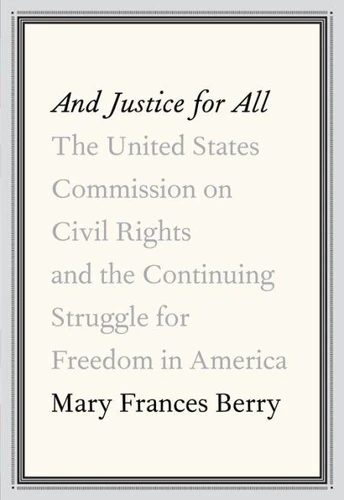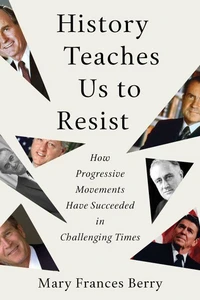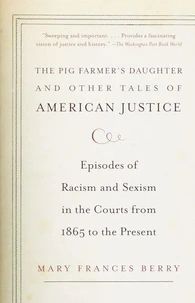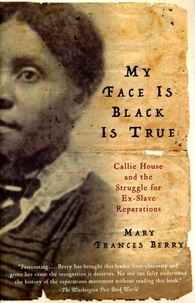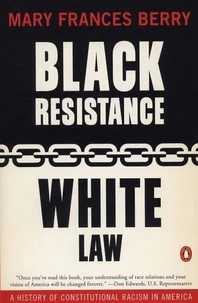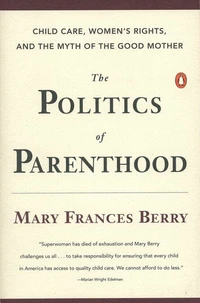And Justice for All
Par :Formats :
Disponible dans votre compte client Decitre ou Furet du Nord dès validation de votre commande. Le format ePub protégé est :
- Compatible avec une lecture sur My Vivlio (smartphone, tablette, ordinateur)
- Compatible avec une lecture sur liseuses Vivlio
- Pour les liseuses autres que Vivlio, vous devez utiliser le logiciel Adobe Digital Edition. Non compatible avec la lecture sur les liseuses Kindle, Remarkable et Sony
- Non compatible avec un achat hors France métropolitaine
 , qui est-ce ?
, qui est-ce ?Notre partenaire de plateforme de lecture numérique où vous retrouverez l'ensemble de vos ebooks gratuitement
Pour en savoir plus sur nos ebooks, consultez notre aide en ligne ici
- Nombre de pages448
- FormatePub
- ISBN978-0-307-27123-5
- EAN9780307271235
- Date de parution20/01/2009
- Protection num.Adobe DRM
- Taille10 Mo
- Infos supplémentairesepub
- ÉditeurKnopf
Résumé
This is the story of the U. S. Commission on Civil Rights, through its extraordinary fifty years at the heart of the civil rights movement and the struggle for justice in America. Mary Frances Berry, the commission's chairperson for more than a decade, author of My Face Is Black Is True ("An essential chapter in American history from a distinguished historian"-Nell Painter), tells of the commission's founding in 1957 by President Eisenhower, in response to burgeoning civil rights protests; how it was designed to be an independent bipartisan Federal agency-made up of six members, with no more than three from one political party, free of interference from Congress and presidents-beholden to no government body, with full subpoena power, and free to decide what it would investigate and report on.
Berry writes that the commission, rather than producing reports that would gather dust on the shelves, began to hold hearings even as it was under attack from Southern segregationists. She writes how the commission's hearings and reports helped the nonviolent protest movement prick the conscience of the nation then on the road to dismantling segregation, beginning with the battles in Montgomery and Little Rock, the sit-ins and freedom rides, the March on Washington.
We see how reluctant government witnesses and local citizens overcame their fear of reprisal and courageously came forward to testify before the commission; how the commission was instrumental in passing the Civil Rights Act of 1964 and the Voting Rights Act of 1965; how Congress soon added to the commission's jurisdiction the overseeing of discriminating practices-with regard to sex, age, and disability-which helped in the enactment of the Age Discrimination Act of 1978 and the Americans With Disabilities Act of 1990.
Berry writes about how the commission's monitoring of police community relations and affirmative action was fought by various U. S. presidents, chief among them Ronald Reagan and George W. Bush, each of whom fired commissioners who disagreed with their policies, among them Dr. Berry, replacing them with commissioners who supported their ideological objectives; and how these commissioners began to downplay the need to remedy discrimination, ignoring reports of unequal access to health care and employment opportunities.
Finally, Dr. Berry's book makes clear what is needed for the future: a reconfigured commission, fully independent, with an expanded mandate to help oversee all human rights and to make good the promise of democracy-equal protection under the law regardless of race, color, sexual orientation, religion, disability, or national origin.
Berry writes that the commission, rather than producing reports that would gather dust on the shelves, began to hold hearings even as it was under attack from Southern segregationists. She writes how the commission's hearings and reports helped the nonviolent protest movement prick the conscience of the nation then on the road to dismantling segregation, beginning with the battles in Montgomery and Little Rock, the sit-ins and freedom rides, the March on Washington.
We see how reluctant government witnesses and local citizens overcame their fear of reprisal and courageously came forward to testify before the commission; how the commission was instrumental in passing the Civil Rights Act of 1964 and the Voting Rights Act of 1965; how Congress soon added to the commission's jurisdiction the overseeing of discriminating practices-with regard to sex, age, and disability-which helped in the enactment of the Age Discrimination Act of 1978 and the Americans With Disabilities Act of 1990.
Berry writes about how the commission's monitoring of police community relations and affirmative action was fought by various U. S. presidents, chief among them Ronald Reagan and George W. Bush, each of whom fired commissioners who disagreed with their policies, among them Dr. Berry, replacing them with commissioners who supported their ideological objectives; and how these commissioners began to downplay the need to remedy discrimination, ignoring reports of unequal access to health care and employment opportunities.
Finally, Dr. Berry's book makes clear what is needed for the future: a reconfigured commission, fully independent, with an expanded mandate to help oversee all human rights and to make good the promise of democracy-equal protection under the law regardless of race, color, sexual orientation, religion, disability, or national origin.
This is the story of the U. S. Commission on Civil Rights, through its extraordinary fifty years at the heart of the civil rights movement and the struggle for justice in America. Mary Frances Berry, the commission's chairperson for more than a decade, author of My Face Is Black Is True ("An essential chapter in American history from a distinguished historian"-Nell Painter), tells of the commission's founding in 1957 by President Eisenhower, in response to burgeoning civil rights protests; how it was designed to be an independent bipartisan Federal agency-made up of six members, with no more than three from one political party, free of interference from Congress and presidents-beholden to no government body, with full subpoena power, and free to decide what it would investigate and report on.
Berry writes that the commission, rather than producing reports that would gather dust on the shelves, began to hold hearings even as it was under attack from Southern segregationists. She writes how the commission's hearings and reports helped the nonviolent protest movement prick the conscience of the nation then on the road to dismantling segregation, beginning with the battles in Montgomery and Little Rock, the sit-ins and freedom rides, the March on Washington.
We see how reluctant government witnesses and local citizens overcame their fear of reprisal and courageously came forward to testify before the commission; how the commission was instrumental in passing the Civil Rights Act of 1964 and the Voting Rights Act of 1965; how Congress soon added to the commission's jurisdiction the overseeing of discriminating practices-with regard to sex, age, and disability-which helped in the enactment of the Age Discrimination Act of 1978 and the Americans With Disabilities Act of 1990.
Berry writes about how the commission's monitoring of police community relations and affirmative action was fought by various U. S. presidents, chief among them Ronald Reagan and George W. Bush, each of whom fired commissioners who disagreed with their policies, among them Dr. Berry, replacing them with commissioners who supported their ideological objectives; and how these commissioners began to downplay the need to remedy discrimination, ignoring reports of unequal access to health care and employment opportunities.
Finally, Dr. Berry's book makes clear what is needed for the future: a reconfigured commission, fully independent, with an expanded mandate to help oversee all human rights and to make good the promise of democracy-equal protection under the law regardless of race, color, sexual orientation, religion, disability, or national origin.
Berry writes that the commission, rather than producing reports that would gather dust on the shelves, began to hold hearings even as it was under attack from Southern segregationists. She writes how the commission's hearings and reports helped the nonviolent protest movement prick the conscience of the nation then on the road to dismantling segregation, beginning with the battles in Montgomery and Little Rock, the sit-ins and freedom rides, the March on Washington.
We see how reluctant government witnesses and local citizens overcame their fear of reprisal and courageously came forward to testify before the commission; how the commission was instrumental in passing the Civil Rights Act of 1964 and the Voting Rights Act of 1965; how Congress soon added to the commission's jurisdiction the overseeing of discriminating practices-with regard to sex, age, and disability-which helped in the enactment of the Age Discrimination Act of 1978 and the Americans With Disabilities Act of 1990.
Berry writes about how the commission's monitoring of police community relations and affirmative action was fought by various U. S. presidents, chief among them Ronald Reagan and George W. Bush, each of whom fired commissioners who disagreed with their policies, among them Dr. Berry, replacing them with commissioners who supported their ideological objectives; and how these commissioners began to downplay the need to remedy discrimination, ignoring reports of unequal access to health care and employment opportunities.
Finally, Dr. Berry's book makes clear what is needed for the future: a reconfigured commission, fully independent, with an expanded mandate to help oversee all human rights and to make good the promise of democracy-equal protection under the law regardless of race, color, sexual orientation, religion, disability, or national origin.

